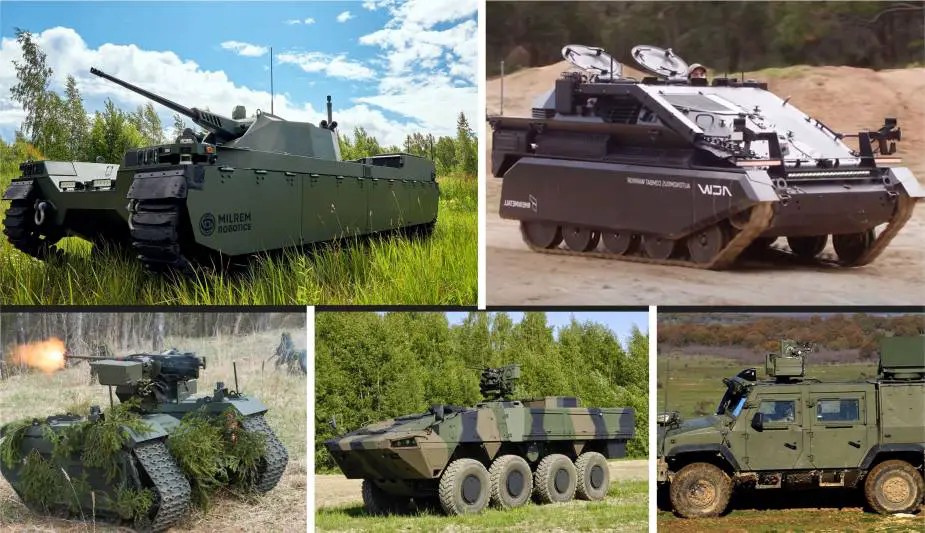Breaking news
New European Defence Agency project seeks to enhance CUGS combat unmanned ground systems technology.
On 1 February, the European Defence Agency (EDA) launched its largest Research and Technology project to develop highly autonomous combat unmanned ground systems. The project, Combat Unmanned Ground Systems (CUGS), brings together nine member states and 28 European industry partners. With a € 35.5 million budget and running for 36 months, CUGS aims to define, design and develop a set of functional modules which will be mounted on to existing platforms. The final phase of the project will test full demonstrators for highly autonomous combat unmanned ground systems.
Follow Army Recognition on Google News at this link

The modules will be integrated on several European autonomous ground systems; the mid-sized platforms Themis (Milrem, Estonia) and Wiesel (Rheinmetall, Germany), and large-sized platforms Type X (Milrem, Estonia), Lince 2 VTLM (Iveco, Italy) and Patria AMV (Patria, Finland) (Picture source: EDA)
Autonomous systems provide operational benefits across a very broad range of missions, from intelligence, surveillance, reconnaissance and logistics missions to combat missions. Deploying unmanned systems reduces the danger to human personnel and manned platforms while increasing the robustness, sustainability and resilience of ground systems. It is expected that these systems will play an increased role in future Armed Forces by bringing faster manoeuvrability and more efficient and precise lethal and non-lethal effects, enhancing the efficiency and effectiveness of land systems and ensuring an advantage in respect to the adversary.
CUGS - Adapting European platforms
The functional modules to be developed in the project will ensure autonomous navigation; command, control, communications, and cooperation; and use of weapon systems. The modules will be integrated on several European autonomous ground systems; the mid-sized platforms Themis (Milrem, Estonia) and Wiesel (Rheinmetall, Germany), and large-sized platforms Type X (Milrem, Estonia), Lince 2 VTLM (Iveco, Italy) and Patria AMV (Patria, Finland).
The project will run across three phases; firstly, with the requirements and standard-based system architecture of the full CUGS demonstrator being developed for both the current autonomous platforms and future modules.
The adaptation of the five existing platforms will begin in parallel with the development of the combat functional modules. In the third phase of the project the solutions will be mounted on the platforms and will be tested and evaluated individually and in a cooperative way in relevant environments.
In the testing phase, the adapted unmanned ground systems should be able to autonomously move, navigate, communicate, detect, identify and lock targets, choose weapon systems and test firing sequences and safety aspects.
Humans in the loop
Each type of weapon or type of engagement will require some specificity to reach the requested level of capability with a human in/on the loop. This project will contribute to identifying the adequate level of autonomy for autonomous weapon systems with humans in the loop and to test relevant features in TRL (Technology readiness levels) demonstrators.
The decision to take lethal actions on the targets will remain a human decision. The execution of this project will be made following respect to the European Parliament's “Resolution on autonomous weapon systems (2018/2752(RSP))”.
Pan-European consortium
Due to the growing importance of unmanned ground systems for operations, nine contributing Member States (cMS) decided to launch the Combat Unmanned Ground Systems (CUGS) project. CUGS is a very ambitious and challenging project, led by Italy, that will also bring together the cMS of Belgium, Germany, Estonia, Finland, France, the Netherlands and Poland, as well as Norway.
The project will be carried out by a consortium led by Italy’s Leonardo and involves other 28 consortium members, namely Iveco, Larimart and MBDA IT, also of Italy, John Cockerill Defence, FN Herstal and the Royal Military Academy of Belgium, Diehl Defence, KMW, MBDA DE and Rheinmetall of Germany, Milrem Robotics, Estonia and the Estonian Military Academy of Estonia, Patria and Bittium of Finland, Nexter, Safran, Thales, MBDA FR and Arquus of France, TNO, Demcon and NCIM of the Netherlands, Kongsberg and FFI of Norway, and WAT, PIAP, ZMT and ASW of Poland.
As a project managed by EDA, the initiative is co-funded by the Member States and additional participants can opt-in.


























